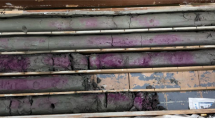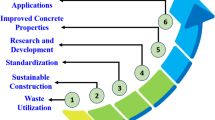Abstract
This study aimed to determine the effect of graphite additive on the strength parameters of clayey sand. Compaction, unconfined compression strength, shear strength, and permeability tests on clayey sand samples were conducted under non-stabilized and stabilized conditions containing varying amounts of graphite. The results were analyzed, and the soil microstructure was investigated using scanning electron microscopy (SEM) and X-ray diffraction (XRD) on non-stabilized and stabilized samples. After 28 days, the results indicated an increase in graphite content and that curing increased the compression strength of the stabilized sample to 340% of that of the non-stabilized sample with a 20% graphite content. The graphite content increased the internal friction angle, reaching a maximum of 59% for the sample stabilized with 5% graphite. Cohesion, maximum dry unit weight, optimum water content, and permeability coefficient decreased by 12.5%, 7.3%, 21%, and 95.5%, respectively, in the stabilized sample with 25% graphite. SEM images indicated that the flocculated continuous structure of the soil resulted in a change in the engineering parameters studied.










Similar content being viewed by others
References
Arabania M, Haghib AK, Moradic Y (2012) Evaluation of mechanical properties improvement of clayey sand by using carbon nanotubes. In: Proceedings of the 4th international conference on nanostructures (ICNS4), Kish Island, I.R. Iran. 1567–1569
Cao M, Zhang H, Zhang C (2016) Effect of graphene on mechanical properties of cement mortars. Journal of the South-Central University 23(4):919–925
Cui X, Sun S, Han B, Yu X, Ouyang J, Zeng S, Ou J (2017) Mechanical, thermal and electromagnetic properties of nano graphene platelets modified cementitious composites. Compos A Appl Sci Manuf 93:49–58
Du H, Dai Pang S (2015) Mechanical response and strain sensing of cement composites added with graphene nanoplatelet under tension Nanotechnology in construction. Springer. pp, 377–382.
Gallagher P, Mitchell J (2002) Influence of colloidal silica grout on liquefaction potential and cyclic undrained behavior of loose sand. Soil dynamics and earthquake engineering. 22:1017–1026
Ghasabkolaei N, Janalizadeh A, Roshan N, Ghasemi E (2017) Geotechnical properties of the soils modified with nanomaterials: a comprehensive review. Archives of civil and mechanical engineering. 639–650.
Han B, Zheng Q, Sun S, Dong S, Zhang L, Yu X, Ou J (2017) Enhancing mechanisms of multi-layer graphenes to cementitious composites. Compos A Appl Sci Manuf 101:143–150
Khalid N, Arshad MF, Mukri M, Mohamad K, Kamarudin F (2015) Influence of nano-soil particles in soft soil stabilization. Electron J Geotech Eng 20:731–738
Kodaka T, Ohno Y, Takyu T (2005) Cyclic shear characteristics of treated sand with colloidal silica grout. Proceedings of the International Conference on soil mechanics and geotechnical engineering. Aa Balkema Publishers. 16(2): 401
Manzur T, Yazdani N (2014) Optimum mix ratio for carbon nanotubes in cement mortar. KSCE Journal of civil engineering. (0000) 00(0):1–8.
Meng W, Khayat KH (2016) Mechanical properties of ultra-high-performance concrete enhanced with graphite nanoplatelets and carbon nanofibers. Compos B Eng 107:113–122
Pacovský J, Svoboda J, Zapletal L (2007) Saturation development in the bentonite barrier of the Mock-Up-CZ geotechnical experiment. Physics and Chemistry of the Earth, Parts a/b/c 32(8–14):767–779
Peyvandi A, Soroushian P, Abdol N, Balachandra AM (2013a) Surface-modified graphite nanomaterials for improved reinforcement efficiency in a cementitious paste. Carbon 63:175–186
Peyvandi A, Soroushian P, Balachandra AM, Sobolev K (2013b) Enhancement of the durability characteristics of concrete nanocomposite pipes with modified graphite nanoplatelets. Constr Build Mater 47:111–117
Pakbaz MS, Farzi M (2015) Comparison of the effect of mixing methods (dry vs. wet) on mechanical and hydraulic properties of treated soil with cement or lime. Applied clay science. 105–106:156–169
Ranjbar N, Mehrali M, Alengaram UJ, Jumaat MZ (2015) Graphene nanoplatelet-fly ash-based geopolymer composites. Cem Concr Res 76:222–231
Rodríguez JA, Izarraras VM, Bandini P, Molina JA (2008) Cyclic strength of natural liquefiable sand stabilized with colloidal silica grout. Canadian geotechnical journal. 45:10
Sixuan H (2012) Multifunctional graphite nanoplatelets (GNP) reinforced cementitious composites.
Taha MR, Taha OME (2012) Influence of nanomaterial on the expansive and shrinkage soil behavior. J Nanoparticle Res 14(1190)
Tang YJJ, Ashcroft JM, Chen D, Min GW, Kim CH, Mukherjee B, Larabell C, Keasling JD, Chen FQF (2007) Charge associated effects of fullerene derivatives on microbial structural integrity and central metabolism. Nano Lett 7:754–760
Tao J, Wang X, Wang Z, Zeng Q (2019) Graphene nanoplatelets as an effective additive to tune the microstructures and piezoresistive properties of cement-based composites. Constr Build Mater 209:665–678
Tong T, Fan Z, Liu Q, Wang S, Tan S, Yu Q (2016) Investigation of the effects of graphene and graphene oxide nanoplatelets on the micro-and macro-properties of cementitious materials. Constr Build Mater 106:102–114
Vasieek R (2007) Mock-up-CZ Experiment, CTU Prague, Faculty of Civil Engineering Centre of Experimental Geotechnics
Yonekura R, Miwa M (1993) Fundamental properties of sodium silicate-based grout. Eleventh southeast Asia geotechnical conference, Singapore. 439–444.
Zohhadi N, Aich N, Matta F, Saleh NB, Ziehl P (2015) Graphene nano reinforcement for cement composites. Nanotechnology in construction. (pp. 265–270).
Acknowledgements
The authors would like to express their gratitude to the staff of Iran Khak Company, particularly Mr. Basir, the managing director, for supplying us with laboratory equipment.
Author information
Authors and Affiliations
Corresponding author
Ethics declarations
Conflict of interest
The authors declare no competing interests.
Additional information
Communicated by Zeynal Abiddin Erguler
Rights and permissions
About this article
Cite this article
Rajabi, A.M., Sadeh, M., Mohammadrezaei, M.H. et al. A laboratory investigation of the geomechanical properties of graphite stabilized clayey sands. Arab J Geosci 14, 2720 (2021). https://doi.org/10.1007/s12517-021-09001-2
Received:
Accepted:
Published:
DOI: https://doi.org/10.1007/s12517-021-09001-2




